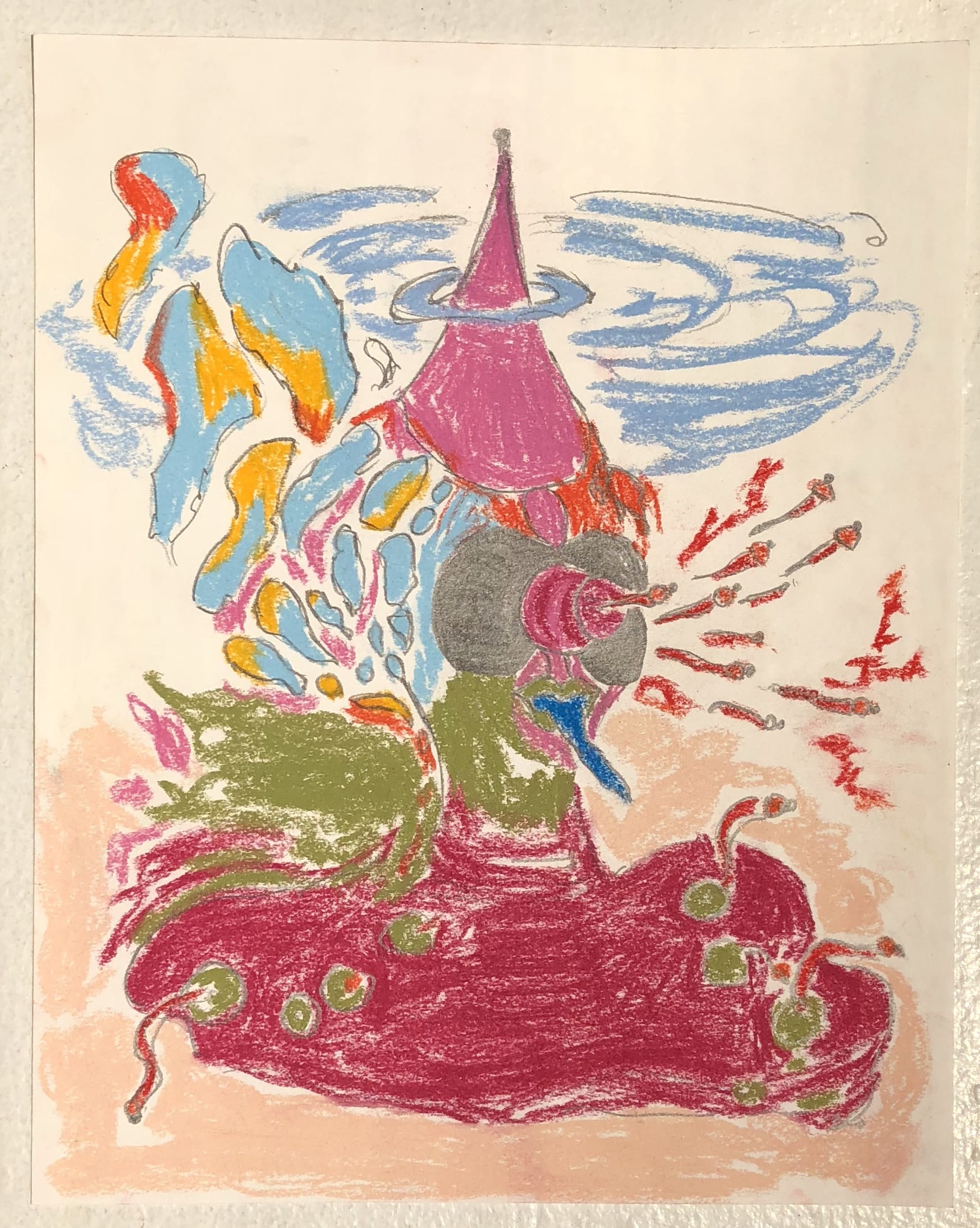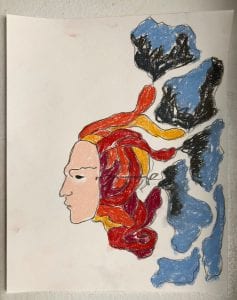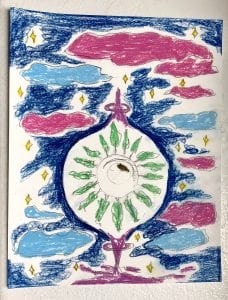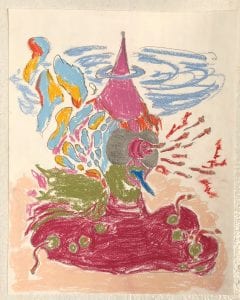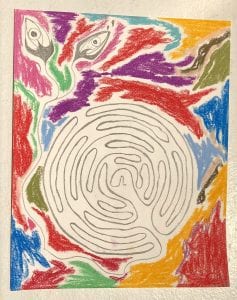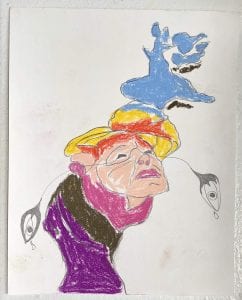For Bridge 1 for my Integrative Studio 2 class, we were given the task to create 5 visual images based on 5 questions that we each came up with in our own time on our observations in Union Square. During the creation and finalisation of my visual images, I have had a documentation process which I will be laying out in this post.
Image 1:
In Union Square, I had very carefully watched an old woman and all the small details about her I could understand from being a silent observer. She was probably hitting around 70 and was dressed in an outfit that made it seem as though she had just been to the gym. Her body type contributed to this observation of mine as well. She was very fit for her age. She also had two bags with her, one of which I almost immediately assumed was for the gym. Her other bag was stuffed with a lot of things as well. She had on glasses that fell to the end of the bridge of her nose and she was read from a thick book. She was somewhere along the middle and what I noticed closely was that she had no bookmark. She was also observing people around her and at one point was feeding the small birds near to her. She even check her phone often. She constantly would lose track as to where she was in that book of hers.
Watching this description in particular made me specifically feel frustration. I can imagine what it feels like trying to read on the top of your spectacles in this heat with so many distractions around you. I would feel frustrated. The space she was seated in wasn’t in the shade. It wasn’t comfortable. The whole situation seemed frustrating to me. I questioned why she wasn’t frustrated. ‘Why does she have this sense of calm while being in a situation that seems horribly inconvenient and frustrating?’
When I think of the feeling of frustration, I think of colours like orange, yellow and red. I think the colours I’m associating with the image are maybe due to the feeling of frustration due to the heat that day but I cannot be sure. The more I process this emotion, I feel like I want to record exactly the image in my mind when I go through this emotion while paying some attention to composition. I also wanted to show bottled up frustration through my illustration.
I decided to create line drawings with different weights while balancing them out with pastels. This is one of my favourite mediums to present my thoughts and feelings in because I feel like its very organic. Working with my hand I can represent what I’m feeling by translating it onto the paper.
Image 2:
As described above, I was very focused in observing an old woman and the way spent her time by herself. While in the first visualisation I created, I was tuning into an emotion of frustration, another feeling that came to me while I was processing it was a feeling of being uncomfortable. I observed the woman in her metal chair. I explained before that it seemed as though she had been at the gym before. I know its so creepy but I was looking at her so carefully, I did notice she seemed sweaty and tired as well. All these were reasons to my first question; why she wasn’t frustrated and appeared so calm. This question and working to create the visualisation led me to question something else which was almost a follow up – ‘Everyone’s idea of comfort isn’t the same but isn’t it somewhat similar?’
I evaluate this question a lot because personally I’ve always assumed that most people find similar things comfortable but thinking about why she appeared so calm in a frustrating situation made me wonder if the situation wasn’t frustrating to her. Just like human minds can find separate things annoying and frustrating, human bodies could possibly sense things differently as well hence, lead to different situations of comfort. Humidity and heat maybe comfortable to someone who has grown up in a place where the climate is always so – this is an example.
The concept of comfort gives me visual elements including peaceful colours like blue and bright pinks which are happy. I associate lots of twisted lines and a certain type of picture with this concept. I decided to use the same materials as my first visualisation to portray my body’s sense of comfort using my mind.
Image 3:
At this point, while observing this woman, I was thinking to myself about how curious I am about her life. I want to know everything. I’m curious about her age; which I was guessing earlier. I’m curious about who she was conversing with on her phone. I was really curious about if she brought the bread knowing she was going to be sitting in Union Square feeding the tiny birdies. I wanted to know if it was a routine. Also, I caught myself thinking a lot about her age and her family. Does she have daughters, sons or both? Do they have families of their own? Do they visit her often?
I have observed this about myself before where in I get so curious about the complete life of strangers who I may see only for a second during the day, maybe on the subway or waiting in line for the elevator. I tried to find a term to describe this and apparently the idea of Sonder – “The realisation that each random passerby is living a life as vivid and complex as your own.” I guess the question I ended up asking was – ‘Do other people experience the realisation that every random passerby has their own complex life and does that make them curious?’
This is a question I’ve asked lots of people and its a feeling I’ve felt my entire life but haven’t given as much thought to it as I did for this project. For my visualisation I really wanted to capture this feeling exactly how my brain visualises it as I see it as a unique feeling. I again ended up using the medium of pencil and pastel on paper. At this point I feel as though I will create all my visual images in this medium as it is really helping me portray what I wish to. I created an image of what I see as an odd way of extraction information from others.
Image 4:
Following my observation of my curiosity, I do believe I was also really curious about if this woman was here as a routine in her daily life. I wanted to know if she brought the bread to feed the birds knowing she was going to see them. The question I was asking was, ‘Does this woman make the effort to come and spend time here in Union Square as a routine activity?’ I was genuinely curious to know this and wonder if people do things like this planned out because I know I dont. I played around with the concept of routine and a more spontaneous way of living and if routine can be considered spontaneous as it was created on a whim at first.
The visual that comes to mind with routine is very generic and often reminds me of diagrams of life cycles from middle school biology so using my medium I decided to create a life cycle as such to symbolize this event and idea of everyday conformity. Instead of creating a generic lifecycle I created a pattern which I let be uninterrupted by the commotion around it.
Image 5:
My last question almost pulled in deep, way deeper than all my other ones. I watched this old woman trying to do all these things at once; reading, using her iPhone, feeding these birds, observing people around her and other very small things that we often wouldn’t notice someone doing like constant adjusting of spectacles, using her finger and spit to turn pages to go back to the spot she was at, tucking her hair behind her ear, etc. Being in this moment, allowing the simultaneous perception, I went to a place of thought I didn’t want to go to. This woman is old. Possibly very very old. I went to the place of thinking about how she may only do the things she is doing a few hundred or thousand times again and – touch wood – maybe even fewer times. This really made me feel sad in a way. ‘Do we really treasure every single small moment in our life where we are doing these small things we don’t even notice?’ This is the question that came to my mind.
I don’t think we value the one second we use to put on our earphones or the two minutes to lace our shoes and tie our belts. Its so weird to think that these are small things we have to do to continue living our lives at ease but they are not big enough things to want to spend time on when you know you don’t have a lot of time left. I was left thinking a lot about old age and being at that stage and how it must feel. Do they feel lonely? Do they feel scared? How does this old woman feel when she looks at young people around her?
For this visualisation, I wanted to create an air of uncertainty. I wanted to be literal but I didn’t know how. How can one really draw this emotion or question and present it visually? I don’t think I even know what I, myself think of when I think of this feeling. While creating the image, I just wanted to play around because I was so unsure, I wanted to use colours like orange and purple which I feel like are just questioning what way I feel about this subject and what energy I want to give to it.
